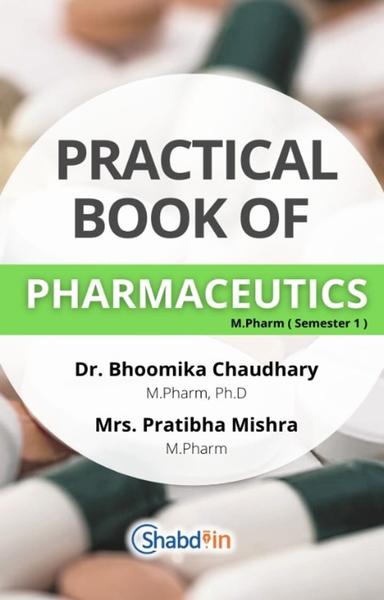AIM: -To study the effect of binder on dissolution of tablets of given drug.
REQUIREMENTS:
Apparatus:-Beaker, stirrer, compression machine.
Chemicals: -Lactose, starch, pvp, talc.
REFERENCES:
1) Lachman. L., Liberman, M.A. and Kanig, J.L., Eds., in: The Theory and Practice of Industrial Pharmacy, 2ndEdn. Lea andFebiger, Philadelphia, 1978; 328.
2) K. P. R. Chowdary, Effect of six binders on the dissolution rate of metformin hydrochloride tablets: JGTPS: 2014.
THEORY:
More than 70% of drug dosage forms are formulated in the form of tablets because of their greatest dose precision, stability, low cost and large scale production, various drug release mechanisms, easy transportation and patient compliance.
Among the main ingredients mixed with the drug when formulation tablet dosage form, binder plays an important role in achieving the desired quality of the tablets.
There are mainly three types of binders namely, sugars, natural, and synthetic/semi-synthetic polymers that can be used in tablet formulation. They may be added either dry or in solution to the tablets prepared by wet granulation. They convert the powder into granules that possesses good flow property and compactability and promotes cohesiveness. Flow property is important to produce tablets with consistent weight and uniform strength. Compactability is important to form a stable and intact compact mass.
Physico-chemical properties and the quality of tablet depend on the type, quantity and the way the binder is added. Therefore, the choice of a binder is extremely important in determining final tablet performance. Therefore, considerable researches have been done to investigate the effects of binder on the quality of the tablets.
Researchers have paid attention on the different subject areas to be investigated to evaluate effect of binder on the tablet performance such as fundamental physico-chemical properties of binder itself , binder-substrate interaction, binder spreading ability, solution binders, natural binders, the effects of binder on bulk density and compactability, toughness and flowability, and the correlation between dissolution and disintegration rate constants.
Tests for Evaluation of Tablets:
1) Weight uniformity test:- Twenty tablets from each formulation were selected randomly and weighed individually using a highly sensitive electronic balance (LcGc). Their mean weights were calculated. Using BP specifications for tablets, deviations and coefficients of variation for each batch were calculated.
2) Hardness test: - Five tablets were selected at random from each formulation to perform this test. Tablet harness tester was used to measure the hardness. Tablet was placed between spindle and anvil of the tester and the calibrated length adjusted to zero. The knob was then screwed to apply a diametric compression force on the tablet and the position on the calibrated length at which the tablet broke was recorded in kg units. A mean hardness was calculated for each batch and thus their standard deviations and coefficient of variations were calculated.
3) Friability test:-Friabulator was used to carry out this test. Twenty tablets were selected at random, dusted and weighed together using the electronic balance (LcGc) and then placed in the Friabilator. The machine was operated for 4 min at 25 rpm for 100 rotations. The tablets were carefully dedusted again and weighed. The percentage losses were calculated for each formulation of the tablets. Friability expressed as weight loss percentage. Test was repeated 3 times and the average was determined.
4) Disintegration time:- The method specified in the USP/NF (1980) was used. The machine used was QC-21 Disintegration test system. Disintegration medium used was 100 ml water maintained at temperature between 35 and 39ºC throughout the experiment. Six tablets selected at random from each formulation were placed one in each of the cylindrical tubes of the basket and then placed the discs in each baskets. The time taken for each tablet to break up into small particles and pass out through the mesh was recorded. Mean disintegration time was calculated for each batch.
Dissolution test (Rotating basket method):- SR8PLUS-Hanson Virtual Instrument, dissolution test station was used to carryout this test. Phosphate buffer (pH 6.8) was used as the dissolution medium. Dissolution test were performed for 2 tablets of each formulation. According to the procedure, 1 L of phosphate buffer (pH 7.2) was filled into each of the six beakers of dissolution apparatus. Two tablets from each formulation were taken and placed in small baskets made from a screen mash. The baskets were then immersed in dissolution medium and rotated at a given speed. Samples (5 ml) were removed at designated time intervals (t0, t10, t20, t30, t40, t50 and t60) and diluted 10 times and assayed for their paracetamol content spectrophotometrically at 202 to 237.5 nm. FORMULATION TABLE:
S.NO | Ingredient (mg/tablet) | F1 Starch paste | F2 PVP | F3 Talc | Category |
| Paracetamol | 500 | 100 | 500 | |
| Binder | 5% | 5% | 5% | |
| Lactose | q.s.to 650mg | q.s.to650mg | q.s.to650mg | |
| Talc | 0.5% | 0.5% | 0.5% | |
| Magnesium Stearate | 1% | 1% | 1% | |
PROCEDURE
Paracetamol (650mg) tablets were prepared by wet granulation method as per the formula given in Table using 3 different binders.The required quantities of drug, lactose and binder as per the formula in each case were blended thoroughly in a dry mortar and granulated with water (q.s) as granulating fluid.The wet mass formed was pressed through mesh no.12 to obtain wet granules.The wet granules were dried at 60oC for 1hour. The dried granules were passed through mesh no.14 to break the aggregates formed and to obtain discrete granules.Talc and magnesium stearate were passed through mesh no.80 and collected on to the bed of tablet granulations prepared and mixed.Calibration of given drug(paracetamol)
The 0.1 N hydrochloric acid is used as media to prepare the stock solution for checking the absorbance at λ max 258 nm. Prepared the concentration in multiple of 2 µg/ml (Range 2, 4….10 µg/ml) and their UV- Spectrophotometer absorbance was taken and prepared the standard curve
RESULTS
Remark:
Practical Performance (2) | Conduct in Lab (2) | Journal (2) | Observations and Results (2) | Viva-Voce (2) | Total (10) | Signature of Faculty In charge |
| | | | | | |
OBSERVATION AND CALCULATION:
Standard calibration curve of in 0.1N HCl
Concentration (ug/ml) | Absorbance 254nm |
5 | |
10 | |
15 | |
20 | |
25 | |
In vitro dissolution study:
Time (min) | %CDR |
0 | |
5 | |
15 | |
30 | |
45 | |
60 | |
EXPERIMENT NO: 11






